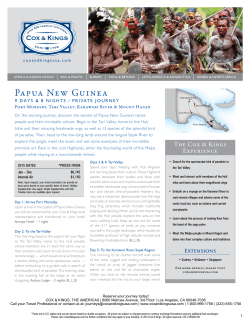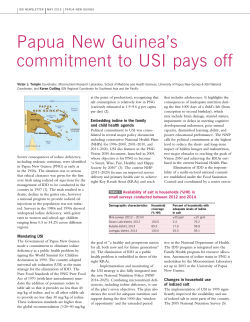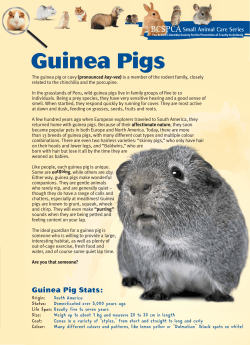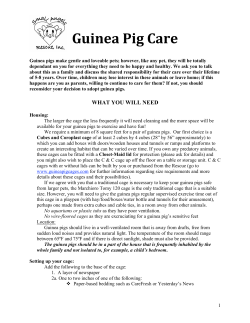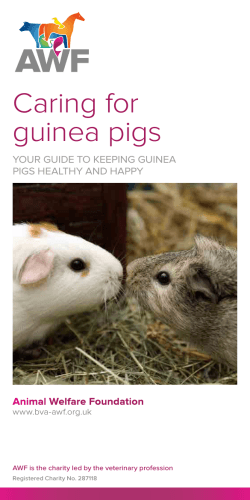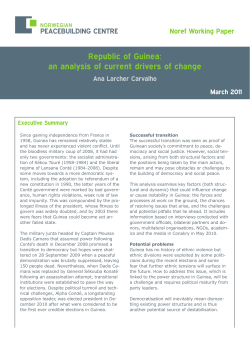
Document 236021
Podcasts – Themes – Papua New Guinea Introduction Download the LearnEnglish Themes podcast. You’ll find more information on this page: http://www.britishcouncil.org/learnenglish-podcasts-themes.htm This support pack contains the following materials: • the article that you can listen to in the podcast • two optional comprehension activities based on the article • links to other activities on the LearnEnglish website on this theme (Papua New Guinea). Read the article Papua New Guinea by Richard Sidaway Why New Guinea? One of the first Europeans to arrive in the 16th century from Portugal thought the country resembled Guinea in West Africa. turned to mud after the rains and then hardened like cement. Luckily, the town had been evacuated the night before and only five people died. Why Papua? The word comes from the Malay language and means ‘fuzzy-haired’, referring to the natives. P ostage stamps – during the First World War, a set of stamps issued by the former Germany colonial authority was used by the Australian occupying forces who simply added the British King’s initials over the top. This only happened for a short time and as a result they are extremely rare. Today, one stamp originally costing five shillings can now sell for $10,000. Why have such a long name when you can abbreviate it? Papua New Guinea is a bit of a mouthful, so most people shorten it to PNG. Here are some of the many curiosities you might come across if you visit: P idgin – or Tok Pisin, is the language that at least 2 million of the 5 million Papuans use to communicate with each other, in the street or in parliament, on radio and TV, possibly because the island has so many other languages (over 700). Pidgin originated as the lingua franca between foreign traders and natives and denotes any ’language’ which does not have a fully developed grammar and a vocabulary which is a mixture of other languages, in this case Portuguese, English, German and Melanesian. For example, the word for moustache is ‘mausgras’ (mouth grass), child is ‘pikinini’ from the Portuguese word for ‘small’, and ‘raus’ comes from German ‘get out’. A ctive volcanoes – being situated on the edge of the Pacific Ocean, the island has at least fifteen major volcanoes. The provincial capital of Rabaul, once a beautiful coastal town, was almost completely destroyed by the eruption of Tavurvur and Vulcan in 1994. Many buildings collapsed under the weight of volcanic ash which U nusual animals – most people think that marsupials only live in Australia. Not so. There are quite a few weird and wonderful examples here too, like the tree kangaroo, along with egglaying mammals such as the echidna, the New Guinea Singing Dog (see below) and the world’s longest lizard, the Salvatori Monitor, which is over 3 metres long. A mazing birdlife – any ornithologist would jump at the chance to visit New Guinea with its 700 species of birds. The most striking is the Bird of Paradise, whose mating ritual is emulated in the local tribal dances, and whose image adorns banknotes and the country’s flag. Another is the flightless Cassowary, which uses the bony protuberance on the top of its head to force its way through the dense rainforest. Then there are countless variety of parrot, cockatoo and hornbill, not to mention a pigeon the size of a turkey, and the pitihui, thought to be the only known example of a poisonous bird! Page 1 of 3 The United Kingdom’s international organisation for educational opportunities and cultural relations. We are registered in England as a charity. Podcasts – Themes – Papua New Guinea the anthropologist Bronislaw Malinowski in the 1920s. It appeared to show a reversal in the usual gender roles prevailing in most human societies. At the annual Yam Festival, the young maidens were very assertive in their quest for a mate, to the point where it was the custom for groups of adolescent girls to rape lone males. N atural Resources - the country is rich in minerals -gold and copper are mined extensively which together with oil, bring in three quarters of the country’s export earnings. Coconut and palm oil are also significant industries and PNG produces its own tea and coffee. The most spectacular resource – the trees of the rainforest – are being cut down at an alarming rate by loggers, however. Even so, companies have to tread carefully in this country as 97% of the country is owned by the people, and local clans expect compensation for lost land. When a copper mine polluted a river on the island of Bougainville in the 1980s, it provoked a ten year civil war and attempt at independence. E ating people – usually considered to be wrong in most parts of the world, cannibalism used to be very common in parts of PNG, and human flesh, usually of a tribe’s enemies, was a treated as a delicacy. Thankfully, the practice largely disappeared in the 1950s, which was good news for the tourist trade. W orld’s largest butterfly –the Queen Alexandra Birdwing butterfly, with a wingspan of over 30cm, is a tricky creature to find, in spite of its size. It lives only in the coastal rainforest in the northern part of the island, stays mostly up in the canopy, 30 meters from the ground, and only lives for about three months. The caterpillar feeds on a poisonous plant, the pipevine, which makes it toxic to any potential predator. G ender Relations – the Trobriand Islanders aroused great interest amongst students of human nature after the publication of research by U nusual musical instruments – bamboo bands were popular in the islands in the 1970s, musicians who played tubes of bamboo by hitting them with sandals! An older instrument is the nose flute, a piece of bamboo from which sound is produced not by blowing through the mouth but through the nose. The preference for this method of playing may be connected to the idea that breath, which passes through the nasal cavity, is the essence of the human soul. I nfinite variety of plants – there are over 11,000 known types of plant in New Guinea, the most colourful being the country’s orchids, of which there are 3,000 different species. PNG is rich in food plants - tropical fruits, root and leaf vegetables, beans and nuts, along with many herbs, spices and flavourings including pepper, nutmeg, cinnamon, ginger and vanilla. Scientists hope that the islands’ yet uncatalogued plants could also hold cures for HIV, malaria and cancer. N ew Guinea Singing Dog – most dogs whine or howl from time to time, but this species actually sounds like it is singing. The song has been likened to a bird call or even the sounds that whales make. It looks similar to the Australian Dingo with a reddish coat and pointed ears, and was only ‘discovered’ in the 1950s when a pair was taken to a zoo in Sydney. Scientists think it was originally domesticated, and then escaped to the mountain forests where it now makes its home. E arthquakes and tidal waves - several tectonic plates meet under New Guinea and so it suffers from frequent earthquakes. These are often followed by tidal waves or tsunami. In July 1998, after an earthquake measuring 7.1 on the Richter scale, a tsunami ten metres high hit the north coast and more than 3,000 people lost their lives or went missing. Page 2 of 3 The United Kingdom’s international organisation for educational opportunities and cultural relations. We are registered in England as a charity. Podcasts – Themes – Papua New Guinea A irstrips – there were 560 at the last countthat’s one for every 10,000 people. (In comparison, Britain, with ten times the population, has only about 200). Going by plane is the easiest way to travel any distance as there are no railways, and the roads are often poor due to the mountainous terrain. And if you are responsible for a road accident, you may end up having your car stoned and burned, so you’re probably better off flying! After reading Exercise 1 Find the significance of the numbers in the table, which are all from the text. There are two answers for each. 30 700 3,000 10,000 1950s 1. The height above the ground in metres that the largest butterfly in the world usually lives 2. The number of bird species in PNG 3. The number of languages spoken in PNG 4. The number of orchid species in PNG 5. The number of people per airstrip 6. The number of victims of the tsunamis in 1998 7. The value in dollars of a PNG stamp from WW1 8. The wingspan in centimetres of the largest butterfly in the world 9. When cannibalism stopped 10. When the Singing Dog was discovered Exercise 2 What’s the connection between the following pairs of things mentioned in the article? 1. 2. 3. 4. 5. 'Papua’ and ‘mausgras’ Tribal dances and the Bird of Paradise Whales and a species of dog Australia and Germany Earthquakes and tsunamis More activities on this topic You’ll find links to all the following activities connected to the theme of Papua New Guinea at: http://www.britishcouncil.org/learnenglish-central-themes-png.htm • Word game: Pidgin English: Match English words and phrases to their equivalents in the Tok Pisin language of Papua New Guinea. • Story: The Masalai of Lep Island: This Papua New Guinea folk story involves a masalai (a large ugly cannibal, similar to an ogre). • Trivia: Everything you (n)ever wanted to know about Papua New Guinea. • There is also a Papua New Guinea-related cartoon and some carefully selected external links. Answers Exercise 1: 1. 30; 2. 700; 3. 700; 4. 3,000; 5. 10,000; 6. 3,000; 7. 10,000; 8. 30; 9. 1950s; 10. 1950s Exercise 2: 1. hair - papua means fuzzy-haired, mausgras means moustache; 2. some tribal dances are imitations of the movements of the bird of paradise; 3. the song of the New Guinea Singing Dog is supposed to resemble that of whales; 4. Australia used German postage stamps in PNG; 5. earthquakes often cause tsunamis Page 3 of 3 The United Kingdom’s international organisation for educational opportunities and cultural relations. We are registered in England as a charity.
© Copyright 2025

